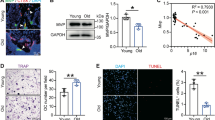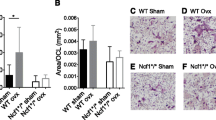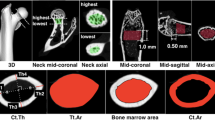Abstract
The objective of the study was to determine the in vivo role of Filamin A (FLNA) in osteoclast generation and function, through the assessment of trabecular bone morphology, bone turnover, and the resulting changes in mechanical properties of the skeleton in mice with targeted deletion of FLNA in pre-osteoclasts. Using a conditional targeted knockdown of FLNA in osteoclasts, we assessed bone characteristics in vivo including micro-computed tomography (micro-ct), histomorphometric analyses, and bone mechanical properties. These parameters were assessed in female mice at 5 months of age, in an aging protocol (comparing 5-month-old and 11-month-old mice) and an osteoporosis protocol [ovariectomized (OVX) at 5 months of age and then sacrificed at 6 and 11 months of age]. In vivo bone densitometry, mechanical and histomorphometric analyses revealed a mild osteoporotic phenotype in the FLNA-null 5-month and aging groups. The WT and FLNA-KO bones did not appear to age differently. However, the volumetric bone mineral density decrease associated with OVX in WT is absent in FLNA-KO-OVX groups. The skeleton in the FLNA-KO-OVX group does not differ from the FLNA-KO group both in mechanical and structural properties as shown by mechanical testing of femora and vertebrae and histomorphometry of vertebrae. Additionally, FLNA-KO femora are tougher and more ductile than WT femora. The result of this study indicates that while FLNA-KO bones are weaker than WT bones, they do not age differently and are protected from estrogen-mediated post-menopausal osteoporosis.






Similar content being viewed by others
References
Shipman P, Walker A, Bichell B (1985) The human skeleton. USA Harvard University Press, Massachusetts
Rucci N (2008) Molecular biology of bone remodeling. Clin Cases Miner Bone Metab 5(1):49–56
Boyle WJ, Simonet WS, Lacey DL (2003) Osteoclast differentiation and activation. Nature 423:337–342
Saltel F, Destaing O, Bard F, Eichert D, Jurdic P (2004) Apatite-mediated actin dynamics in resorbing osteoclasts. Mol Biol Cell 15:5231–5241
Manolagas SC (2000) Birth and death of bone cells: basic regulatory mechanisms and implications for the pathogenesis and treatment of osteoporosis. Endocr Rev 21:115–137
Cooper C (1999) Epidemiology of osteoporosis. Osteoporos Int 9:S2–S8
Glaser DL, Kaplan FS (1997) Osteoporosis. Definition and clinical presentation. Spine 22:12S–16S
Kanis J (2002) Diagnosis of osteoporosis and fracture risk. Lancet 359:1929–1936
Garnero P, Sornay-Rendu E, Chapuy MC et al (1996) Increased bone turnover in late postmenopausal women is a major determinant of osteoporosis. J Bone Miner Res 11:337–349
Pacifici R (1996) Estrogen, cytokines, and pathogenesis of postmenopausal osteoporosis. J Bone Miner Res 8:1043–1051
Riggs BL, Khosla S, Melton L (1998) A unitary model for involutional osteoporosis: estrogen deficiency causes both type I and type II osteoporosis in postmenopausal women and contributes to bone loss in aging men. J Bone Miner Res 13:763–773
Jaffe AB, Hall A (2005) Rho GTPases: biochemistry and biology. Annu Rev Cell Dev Biol 21:247–269
Wang Y, Lebowitz D, Sun C, Thang H, Grynpas MD, Glogauer M (2008) Identifying the relative contributions of Rac1 and Rac2 to osteoclastogenesis. J Bone Miner Res 23:260–270
Ory S, Brazier H, Pawlak G, Blangy A (2005) Rho GTPases in osteoclasts: orchestrators of podosome arrangement. Eur J Cell Biol 87:469–477
Stossel TP, Condeelis J, Cooley L et al (2001) Filamins as integrators of cell mechanics and signalling. Nat Rev Mol Cell Biol 2:138–145
Popowicz GM, Schleicher M, Noegel AA, Holak TA (2006) Filamins: promiscuous organizers of the cytoskeleton. Trends Biochem Sci 31:411–419
Flanagan LA, Chou J, Falet H, Neujahr R, Hartwig JH, Stossel TP (2001) Filamin A, the Arp2/3 complex, and the morphology and function of cortical actin filaments in human melanoma cells. J Cell Biol 155:511–517
Steenblock C, Heckel T, Czupalla C, Santo A, Niehage C, Sztacho M, Hoflack B (2014) The Cdc42 guanine nucleotide exchange factor FGD6 coordinates cell polarity and endosomal membrane recycling in osteoclasts. J Biol Chem 289(26):18347–18359
Sheen VL, Dixon PH, Fox JW et al (2001) Mutations in the X-linked filamin 1 gene cause periventricular nodular heterotopia in males as well as in females. Hum Mol Genet 10:1775–1783
Leung R, Wang Y, Cuddy K, Sun C, Magalhaes J, Grynpas MD, Glogauer M (2010) Filamin A regulates monocyte migration through Rho small GTPases during osteoclastogenesis. J Bone Miner Res 25:1077–1091
Feng Y, Chen MH, Moskowitz IP et al (2006) Filamin A (FLNA) is required for cell-cell contact in vascular development and cardiac morphogenesis. Proc Natl Acad Sci USA 3:19836–19841
Clausen BE, Burkhardt C, Reith W, Renkawitz R, Forster I (1999) Conditional gene targeting in macrophages and granulocytes using LysMcre mice. Transgenic Res 8:265–277
Parfitt AM, Drezner MK, Glorieux FH et al (1987) Bone histomorphometry: standardization of nomenclature, symbols, and units. Report of the ASBMR179 Histomorphometry Nomenclature Committee. J Bone Miner Res 2:595–610
Goldberg S, Georgiou J, Glogauer M, Grynpas MD (2012) A 3D scanning confocal imaging method measures pit volume and captures the role of Rac in osteoclast function. Bone 51:145–152
Lees RL, Heersche JN (1999) Macrophage colony stimulating factor increases bone resorption in dispersed osteoclast cultures by increasing osteoclast size. J Bone Miner Res 6:937–945
Takahata M, Maher JR, Juneja SC, Inzana J, Xing L, Schwarz EM, Berger AJ, Awad HJ (2012) Mechanisms of bone fragility in a glucocorticoid-treated mouse model of rheumatoid arthritis—implications for insufficiency fracture risk. Arthritis Rheum 11:3649–3659
Viguet-Carrin S, Garnero P, Delmas PD (2006) The role of collagen in bone strength. Osteoporos Int 17:319–336
Von der Mark K (1999) Components of the organic extracellular matrix of bone and cartilage: structure and biosynthesis of collagens. In: Seibel M, Robins S, Bilezikian J (eds) Dynamics of bone and cartilage metabolism. Elsevier Inc, Amsterdam, pp 3–18
Hansson T, Roos B, Nachemson A (1980) The bone mineral content and ultimate compressive strength of lumbar vertebrae. Spine 5:46–55
Leichter I, Margulies JY, Weinreb A et al (1982) The relationship between bone density, mineral content, and mechanical strength in the femoral neck. Clin Orthop Relat Res 163:272–281
Hayashi K, Altman A (2006) Filamin A is required for T cell activation mediated by protein kinase C-theta. J Immunol 177(3):1721–1728
Sasaki A, Masuda Y, Ohta Y, Ikeda K, Watanabe K (2001) Filamin associates with Smads and regulates transforming growth factor-beta signaling. J Biol Chem. 21:17871–17877
Pacifici R, Rifas L, McCracken R, Avioli LV (1990) The role of interleukin-1 in postmenopausal bone loss. Exp Gerontol 25:309–316
Hahnel R, Gschwendt M (1995) The interaction between protein-kinase-C (PKC) and estrogens. Int J Oncol 10:11–16
Marino M, Galluzzo P, Ascenzi P (1996) Estrogen signaling multiple pathways to impact gene transcription. Curr Genomics 8:497–508
Kimble RB, Srivastava S, Ross FP, Matayoshi A, Pacifici R (1996) Estrogen deficiency increases the ability of stromal cells to support murine osteoclastogenesis via an interleukin-1 and tumor necrosis factor-mediated stimulation of macrophage colony-stimulating factor production. J Biol Chem 46:28890–28897
Leonardi A, Ellinger-Ziegelbauer H, Franzoso G, Brown K, Siebenlist U (2000) Physical and functional interaction of Filamin (actin-binding protein-280) and tumor necrosis factor receptor-associated factor 2. J Biol Chem 275:271–278
Acknowledgments
The work was supported by a CIHR operating grant to Dr. Michael Glogauer. Stephanie Goldberg participated in making substantial contributions to conception and design, acquisition of data and analysis, and interpretation of data. Stephanie Goldberg, Marc Grynpas, and Michael Glogauer participated in drafting the manuscript and revising it critically for important intellectual content. Marc Grynpas and Michael Glogauer approved the final version of the submitted manuscript, and all three authors agreed to be accountable for all aspects of the work in ensuring that questions related to the accuracy or integrity of any part of the work were appropriately investigated and resolved. Judah Glogauer participated in data acquisition.
Conflict of interest
Stephanie Goldberg, Judah Glogauer, Marc Grynpas, and Michael Glogauer have no conflicts of interest to disclose.
Human and Animal Rights and Informed Consent
All procedures followed were in accordance with the ethical standards of the responsible committee on human experimentation (institutional and national) and with the Helsinki Declaration of 1975, as revised in 2000 (5). Informed consent was obtained from all patients for being included in the study.
Author information
Authors and Affiliations
Corresponding author
Rights and permissions
About this article
Cite this article
Goldberg, S., Glogauer, J., Grynpas, M.D. et al. Deletion of Filamin A in Monocytes Protects Cortical and Trabecular Bone from Post-menopausal Changes in Bone Microarchitecture. Calcif Tissue Int 97, 113–124 (2015). https://doi.org/10.1007/s00223-015-9994-4
Received:
Accepted:
Published:
Issue Date:
DOI: https://doi.org/10.1007/s00223-015-9994-4




